Vardges Sureniants
Vardges Sureniants (Armenian: Վարդգես Սուրենյանց; 27 February 1860 – 6 April 1921) was an Armenian painter, sculptor, illustrator, translator, art critic, and theater artist. He is considered the founder of Armenian historical painting.[1][2] His paintings feature scenes from Armenian fairy-tales and various historical events. Although Sureniants had one exhibition dedicated to his works in his lifetime, he was admired by many of his contemporaries which include many well-known figures in Armenian and Russian society including Martiros Saryan, Ilya Repin, and Vladimir Stasov.
Vardges Sureniants | |
|---|---|
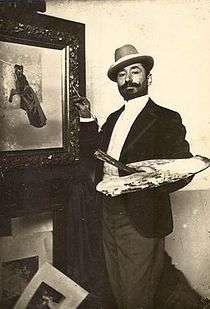 | |
| Born | 27 February [O.S. 10 March] 1860 Akhaltsikhe, Tiflis Governorate, Russian Empire |
| Died | 6 April 1921 (aged 61) |
| Nationality | Armenian |
| Known for | Painter |
Life
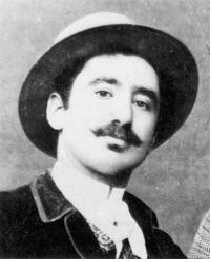
Vardges Sureniants was born in Akhaltsikhe, Russian Empire in modern-day Georgia on 27 February 1860.[3] His father, Hakop Sureniants, was a priest and taught religious history.[4] The Sureniants family then moved to Simferopol in 1868. Sureniants' father was then appointed a presbyter to the Armenian diocese in Moscow. When in Moscow, Sureniants had an opportunity to study at the prestigious Armenian Lazarian School located in the city.[3] In 1876, he furthered his education at the Moscow School of Painting, Sculpture and Architecture where he graduated in 1879.[5] That same year Sureniants went to Munich, Germany where he studied architecture at the Academy of Fine Arts, receiving more education in painting and ultimately graduating from the academy in 1885.[3][5]
He traveled to Italy in 1881 and visited the island of San Lazzaro degli Armeni where the Armenian Catholic congregation of the Mechitarists is located. In their library he studied Armenian fine art and Armenian manuscripts. He created portraits of Mikayel Chamchian and others. In 1883, he wrote his first article which was published in the Armenian newspaper Meghu Hayastani entitled "A Few Words about Armenian Architecture".[5] In 1885–87, he traveled to the Persian cities of Tabriz, Tehran, Isfahan and Shiraz with Russian orientalist Valentin Zhukovski's expedition.[3][4] After his travels, Sureniants translated William Shakespeare's Richard III and sent it to Constantinople so that actor Bedros Adamian could have it produced.[11] In 1890–91 he taught art history at the Gevorkian Seminary in Armenia.[11][12]
In 1892 Sureniants visited Ani, Lake Sevan and became familiar with the everyday customs of rural Armenian life.[3][4] In the same year, he went to Moscow where he became involved in many artistic circles.[3] In 1901 an exhibition of his works was held in Baku. This was to be Sureniants' only exhibition in his lifetime.[13] In 1901–02 he sculpted a bust of the Russian Armenian painter Ivan Aivazovsky.[4]
During the Armenian Genocide, Sureniants painted many paintings of survivors who found refuge in Russian Armenia.[14] In 1916 he went to Tiflis, where he and other artists such as Mardiros Saryan and Panos Terlemezian founded the Armenian Artistic Society.[12][15]
In 1917 Sureniants moved to Yalta where he was commissioned to draw the decorations for the newly built Armenian cathedral. Sureniants decorated the altar, walls, and dome of the church.[16] While decorating the church Surentiants suffered a grave illness. He died on 6 April 1921, and is buried in the premises of the Armenian church of Yalta.[17]
Work and style
In his early career as an artist, Sureniants became interested in caricatures and sketches during his study at the Lazarian School. While in Munich, Sureniants got into painting and line drawing. Some of his caricatures were published in the Fliegende Blätter magazine. He was also known for his illustrations of famous literary works, including Ferdowsi's Shahname, Alexander Pushkin's The Fountain of Bakhchisaray, the fairy tales of Oscar Wilde and works by the Belgian poet Georges Rodenbach, the Armenian writer Smbat Shahaziz and Alexander Tsaturyan.[2]
Sureniants is often categorized as a realist painter.[9] He once said that "painters must paint life the way it appears in front of our eyes."[18] His style reflected this notion through his depiction of landscapes and historical events. He played an instrumental role in reviving Armenian historical events through the medium of art.[19] Pointilism was one of his chief techniques.[20]
Legacy
Despite his success as a painter, Sureniants had only one exhibition in his lifetime. However, there have been many posthumous exhibitions in his honor, including exhibitions at Venice (1924), Yerevan (1931, 1941, 1960, 2010) and elsewhere.[21] The most recent exhibition was held in 2010 in honor of Sureniants' 150th anniversary.[22] During the exhibition, the Prime Minister of Armenia, Tigran Sargsyan, said that:
Sureniants can well be ascribed to the family of the world's best artists, and our State has much to do in this respect: the celebration of his 150th anniversary should launch the process of his international recognition. I happened to discover an exciting detail as I familiarized myself with his life experience. During his lifetime, Sureniants had only one personal exposition: in Baku in 1901. Our initiative is exceptional from this point of view as we have tried to bring to the public’s attention all we could collect over time.[22]
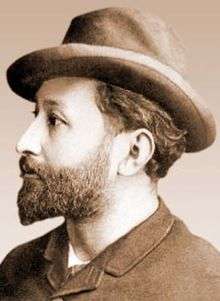
Sureniants was well known in the art community and enjoyed personal friendships with a number of famous Russian artists including Igor Grabar, Vasily Polenov, Aleksandr Golovin and the sculptors Alexander Matveyev and Nikolay Andreyev.[3][4]
One admirer of his was the Russian painter Ilya Repin, who said:
The paintings of Vardges Sureniants fascinated me the first time I saw them; he is a bright exemplar of the new [painting] school – his originality is of unusually high proportions, and his passionate love for the slightest detail is outstanding.[23]
Another admirer was the Russian art critic Vladimir Stasov, who said:
Sureniants' superior skill in painting the architecture of the East while paying close attention to the intricate details of its motifs provides his paintings a splendor of colorfulness.[23]
The Armenian painter, Martiros Saryan, once said of Sureniants that, "with a broad understanding of culture, his best works contained the beating heart of the Armenian nation" and added, "It is therefore certain that Sureniants will last as long as the Armenian people shall last."[23][24]
Gallery
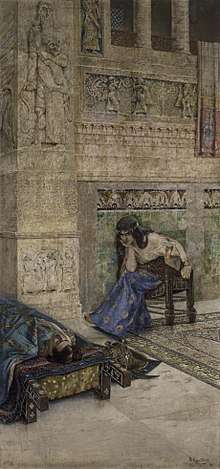 Shamiram and Ara the Beautiful
Shamiram and Ara the Beautiful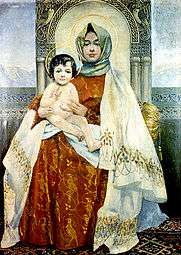 Virgin and Child
Virgin and Child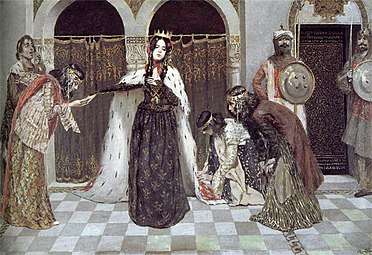 Return of Queen Zabel of Armenia
Return of Queen Zabel of Armenia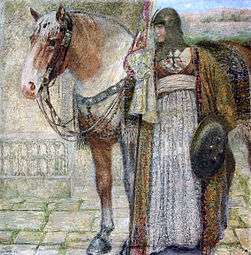 Knight-Woman
Knight-Woman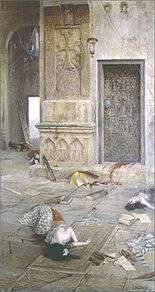 After the Massacre
After the Massacre
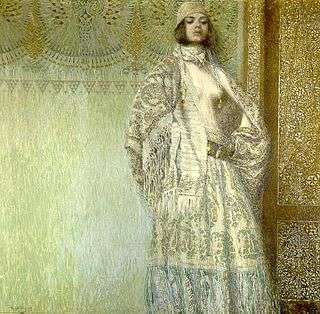
.jpg)
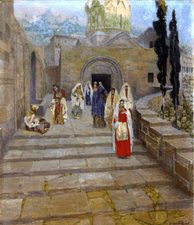 Women Leaving a Church at Ani
Women Leaving a Church at Ani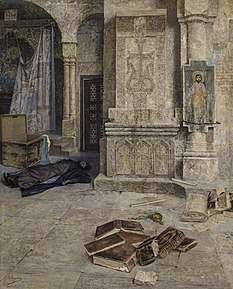 Desecrated Shrine
Desecrated Shrine

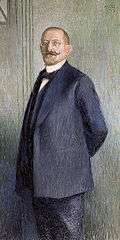 Unknown man
Unknown man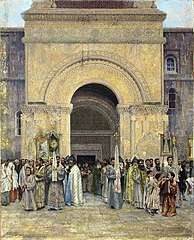 The Departure of the Procession from St. Etchmiadzin Cathedral
The Departure of the Procession from St. Etchmiadzin Cathedral Portrait of Idleson
Portrait of Idleson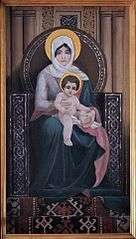 The Virgin
The Virgin
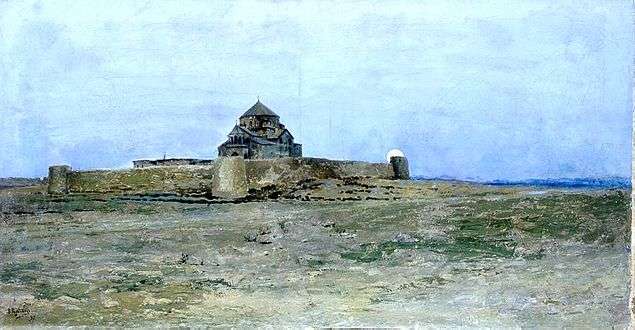 The monastery of St. Hripsime
The monastery of St. Hripsime
Notes
- Zenian, David (1 July 1996). "The National Gallery of Armenia: A Treasure House of Art". AGBU News Magazine. Armenian General Benevolent Union. Retrieved 2 December 2013.
- "SURENIANTS AND HIS CONTEMPORARIES". National Gallery of Armenia.
- Mikayelian, M (1985). Hambardzumyan, Viktor (ed.). Soviet Armenian Encyclopedia Volume 11 (in Armenian). Yerevan: Armenian Encyclopedia Publishing. pp. 205–207.
- Mikayelyan, Martin (2003). Vardges Sowrenyants=Vardges Sureniants. Erevan: Anahit.
- Adamyan 2012, p. 7.
- Holding 2011, p. 47.
- "Vardges Sureniants" (in Russian). Khachkar Journal.
Художник, прекрасно осознающий свое место в пространстве армянской культуры, не мог не обратиться к теме Геноцида армян – погромов и резни армян в Турции 1894–1895 годов. Эмоциональный тонус полотен «Попранная святыня», «После резни» буквально наэлектризован хаотической стихией трагизма.
- Ghazinyan, Aris (October 2008). "Armenian as International Painters". National Idea (in Armenian).
1890–ական թթ. Սուրենյանցը ստեղծում է հայոց ջարդերին նվիրված կտավների մի ամբողջ շարք. «Լքյալը», «Ոտնահարված սրբությունը», «Ջարդից հետո»-ն...
- Patkerasrah, Hayastani Petakan (1984). Martin Mikaelian (ed.). Art Gallery of Armenia, Yerevan. Aurora Art Publishers.
- "Armenian Genocide in Art". Avarayr. 24 April 2010. Archived from the original on 10 May 2010.
Vardges Surenyants (1860–1921), a native of Tiflis, painted several works that depicted the suffering of his kin under Ottoman rule following the Hamidian Massacres. The Abandoned (1899) After the Massacre (1899) Profanation of the Shrine (1895)
- Adamyan 2012, p. 8.
- Mouradian 1995, p. 171.
- Adamyan 2012, p. 9.
- Adamyan 2012, p. 3.
- Shushanik, Zohrabyan. "The Tendencies of Symbolism in Vardges Surenyants' Art" (PDF). Historical-Philological Journal (in Armenian): 57–73. ISSN 0135-0536.
- Aleksandrovich Ponomarenko, Konstantin (1971). Yalta: a short guide (3 ed.). Krym Publishers. p. 41.
- Adamyan 2012, p. 10.
- Adamyan 2012, p. 13.
- Andreĭ Konstantinovich Lebedev, ed. (1974). Передвижники. Aurora Art. p. 288.
- Adalian 2010, p. 190.
- Adamyan 2012, p. 12.
- "An exhibition in place on 150th anniversary of Vardges Sureniants". Government of the Republic of Armenia. 26 November 2010.
- Adamyan 2012, p. 15.
- From the original Armenian: "Բարձր կուլտուրայով կատարված նրա լավագոյն գործերում ուժեղ տրոփում է Հայաստանի սիրտը, դրա համար Վարդգես Սուրենյանցը կապրի այնքան, որքան կապրի հայ ժողովուրդը..."
References
- Adalian, Rouben Paul (2010). Historical dictionary of Armenia (2nd ed.). Lanham, MD: Scarecrow Press. ISBN 0810874504.CS1 maint: ref=harv (link)
- Adamyan, A. (2012). "Vartkes Sureniants" (PDF). Cultural Association of the Armenian National Library (in Armenian). National Library of Armenia. Archived from the original (PDF) on 4 March 2016. Retrieved 4 March 2016.CS1 maint: ref=harv (link)
- Holding, Nicholas Holding with Deirdre (2011). Armenia with Nagorno Karabagh (3rd ed.). Chalfont St. Peter, Bucks: Bradt. p. 47. ISBN 1841623458.CS1 maint: ref=harv (link)
- Mouradian, George (1995). Armenian infotext (1st ed.). Southgate, Mich.: Bookshelf Publishers. p. 171. ISBN 0963450921.CS1 maint: ref=harv (link)
External links
